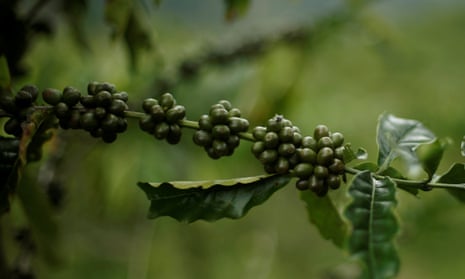It’s one of the most common gardening tips going: apply spent coffee grounds around your garden for amazing results. A quick internet search for “coffee grounds + plants” will draw up close to four million hits, with consistent claims they can add essential minerals to the soil, boost populations of friendly soil bacteria and even reduce the pH of growing media for acid-loving plants like rhododendrons. In fact, on a trip to an achingly eco organic coffee shop in San Francisco last year I saw big barrels of used coffee grounds with scoops and brown bags, free to customers to collect, under a sign detailing their many horticultural virtues. What a great idea!
Always keen to try out a quirky horticultural tip, and being a bit of a caffeine fiend, I decided to put the theory to the test this summer on two identical vegetable beds containing a mix of tomatoes, lettuce, herbs and flowers. Now, this was hardly a rigorous scientific trial, just a rough-and-ready experiment to satisfy passing curiosity. I’d just dump my daily coffee grounds on the surface as a mulch once they had cooled (the way books and blogs suggest), creating a beautiful dark inch-thick layer of coffee compost by the end of the summer.
And the results? Well, here’s the deal. The crop yield and growth of pretty much everything in the coffee bed became noticeably worse within about two weeks of application. Plant growth slowed, some developed leaf yellowing, others defoliated and died. Seedling germination in some cases was almost completely inhibited. While some species looked OK, none of the plants in the coffee group proved better than my basic control. But it’s just adding organic matter. What went wrong?
So I had a look at the scientific literature, and frankly I kicked myself. Coffee grounds are of course a rich source of caffeine – in fact they can be richer than coffee itself, depending on brewing technique. One of the key functions of caffeine in the plants that produce it is allelopathy – the ability to reduce competition from surrounding species by suppressing their growth. Caffeine is packed into coffee seeds for the very function of suppressing the germination of other seeds.
There is a stack of studies to suggest it also stalls root growth in young plants, preventing their uptake of water and nutrients. Yet others have shown it has antibacterial effects (so much for boosting soil bacteria). And guess what? It isn’t even always very acidic. OK, its effects have varied widely depending on plant species, but it’s never shown colossal benefits that could outweigh the risks. I love a quirky piece of hort advice, and some are repeated so often you assume they are true, but often they call them old wives’ tales for a reason.
Email James at james.wong@observer.co.uk or follow him on Twitter @Botanygeek

Comments (…)
Sign in or create your Guardian account to join the discussion